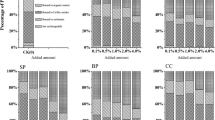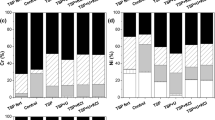Abstract
Phosphorus-bearing materials have been widely applied in immobilization of heavy metals in contaminated soils. However, the study on the stability of the initially P-induced immobilized metals in the contaminated soils is far limited. This work was conducted to evaluate the mobility of Pb, Cu, and Zn in two contrasting contaminated soils amended with phosphate rock tailing (PR) and triple superphosphate fertilizer (TSP), and their combination (P + T) under simulated landfill and rainfall conditions. The main objective was to determine the stability of heavy metals in the P-treated contaminated soils in response to the changing environment conditions. The soils were amended with the P-bearing materials at a 2:1 molar ratio of P to metals. After equilibrated for 2 weeks, the soils were evaluated with the leaching procedures. The batch-based toxicity characteristic leaching procedure (TCLP) was conducted to determine the leachability of heavy metals from both untreated and P-treated soils under simulated landfill condition. The column-based synthetic precipitation leaching procedure (SPLP) were undertaken to measure the downward migration of metals from untreated and P-treated soils under simulated rainfall condition. Leachability of Pb, Cu, and Zn in the TCLP extract followed the order of Zn > Cu > Pb in both soils, with the organic-C- and clay-poor soil showing higher metal leachability than the organic-C- and clay-rich soil. All three P treatments reduced leachability of Pb, Cu, and Zn by up to 89.2, 24.4, and 34.3 %, respectively, compared to the untreated soil, and TSP revealed more effectiveness followed by P + T and then PR. The column experiments showed that Zn had the highest downward migration upon 10 pore volumes of SPLP leaching, followed by Pb and then Cu in both soils. However, migration of Pb and Zn to subsoil and leachate were inhibited in the P-treated soil, while Cu in the leachate was enhanced by P treatment in the organic-C-rich soil. More than 73 % P in the amendments remained in the upper 0–10 cm soil layers. However, leaching of P from soluble TSP was significant with 24.3 % of P migrated in the leachate in the organic-C-poor soil. The mobility of heavy metals in the P-treated soil varies with nature of P sources, heavy metals, and soils. Caution should be taken on the multi-metal stabilization since the P amendment may immobilize some metals while promoting others’ mobility. Also, attention should be paid to the high leaching of P from soluble P amendments since it may pose the risk of excessive P-induced eutrophication.






Similar content being viewed by others
References
Adriano DC (2001) Trace elements in the terrestrial environments, 2nd edn. Springer, New York
American Society for Testing and Materials (ASTM) (2000) Annual Book of ASTM Standards, Soil and Rock, vol. 4.08
Beesley L, Moreno-Jimenez E, Clemente LR, Dickinson N (2010) Mobility of arsenic, cadmium and zinc in a multi-element contaminated soil profile assessed by in-situ soil pore water sampling, column leaching and sequential extraction. Environ Pollut 158:155–160
Brown S, Chaney R, Hallfrisch J, Ryan JA, Berti WR (2004) In situ soil treatments to reduce the phyto- and bioavailability of lead, zinc, and cadmium. J Environ Qual 33:522–531
Cao XD, Ma LQ, Chen M, Singh SP, Harris WG (2002) Impacts of phosphate amendments on lead biogeochemistry at a contaminated site. Environ Sci Technol 36:5296–5304
Cao XD, Ma LQ, Singh SP, Chen M, Harris WG (2003) Phosphate-induced metal immobilization in a contaminated site. Environ Pollut 122:19–28
Cao XD, Ma LQ, Rhue DR, Appel CS (2004) Mechanisms of lead, copper, and zinc retention by phosphate rock. Environ Pollut 131:435–444
Cao XD, Dermatas D (2008) Evaluating the applicability of regulatory leaching tests for assessing lead leachability in contaminated shooting range soils. Environ Monit Assess 139:1–13
Cao XD, Wahbi A, Ma LQ, Li B, Yang YL (2009) Immobilization of Zn, Cu, and Pb in contaminated soils using phosphate rock and phosphoric acid. J Hazard Mater 164:555–564
Chen GQ, Zeng GM, Du CY, Huang DL, Tang L, Wang LA, Shen GL (2010) Transfer of heavy metals from compost to red soil and groundwater under simulated rainfall conditions. J Hazard Mater 181:211–216
Cotter Howells J, Caporn S (1996) Remediation of contaminated land by formation of heavy metal phosphates. Appl Geochem 11:335–342
Fang YY, Cao XD, Zhao L (2012) Effects of phosphorus amendments and plant growth on the mobility of Pb, Cu, and Zn in a multi-metal-contaminated soil. Environ Sci Pollut Res 19:1659–1667
Halim CE, Scott JA, Amal R, Short SA, Beydoun D, Low G, Cattle J (2005) Evaluating the applicability of regulatory leaching tests for assessing the hazards of Pb-contaminated soils. J Hazard Mater 120:101–111
Hettiarachchi GM, Pierzynski GM, Ransom MD (2001) In situ stabilization of soil lead using phosphorus. J Environ Qual 30:1214–1221
Kumpiene J, Lagerkvist A, Maurice C (2008) Stabilization of As, Cr, Cu, Pb and Zn in soil using amendments—a review. Waste Manage 28:215–225
Kunhikrishnan A, Bolan NS, Müller K, Laurenson S, Naidu R, Kim W (2012) The influence of wastewater irrigation on the transformation and bioavailability of heavy metal(loid)s in soil. Adv Agron 115:215–297
Laperche V, Gaddam SJ, Logan P, Traina TJ (1996) Chemical and mineralogical characterizations of Pb in a contaminated soil: reactions with synthetic apatite. Environ Sci Technol 30:3321–3326
Lebeau T, Braud A, Jezequel K, Bazot S (2009) Enhanced phytoextraction of an agricultural Cr and Pb-contaminated soil by bioaugmentation with siderophore-producing bacteria. Chemosphere 74:280–286
Lee SS, Lim JE, Samy AM, Abd EA, Choi B, Oh SE, Moon DH, Ok YS (2012) Heavy metal immobilization in soil near abandoned mines using eggshell waste and rapeseed residue. Environ Sci Pollut R. doi:10.1007/s11356-012-1104-9
Liu RQ, Zhao DY (2007) In situ immobilization of Cu(II) in soils using a new class of iron phosphate nanoparticles. Chemosphere 68:1867–1876
Ma Y, Prasad MNV, Rajkumar M, Freitas H (2011) Plant growth promoting rhizobacteria and endophytes accelerate phytoremediation of metalliferous soils. Biotechnol Adv 29:248–258
Miretzky P, Fernandez-Cirelli A (2008) Phosphates for Pb immobilization in soils: a review. Environ Chem Lett 6:121–133
Olsen SR, Sommers LE, Phosphorus, et al. (eds) (1982) Methods of soil analysis Part 2: Chemical and microbiological properties. vol. 9, second ed., ASA. Madison, Wisconsin 407–414
Park JH, Bolan N, Megharaj M, Naidu R (2011) Isolation of phosphate solubilizing bacteria and their potential for lead immobilization in soil. J Hazard Mater 185:829–836
Sayyad G, Afyuni M, Mousavi SF, Abbaspour KC, Richards BK, Schulin R (2010) Transport of Cd, Cu, Pb and Zn in a calcareous soil under wheat and safflower cultivation—a column study. Geoderma 154:311–320
Schwab P, Zhu D, Banks MK (2007) Heavy metal leaching from mine tailings as affected by organic amendments. Bioresour Technol 98:2935–2941
Sneddon IR, Orueetxebarria M, Hodson ME, Schofield PF, Valsami-Jones E (2006) Use of bone meal amendments to immobilise Pb, Zn and Cd in soil: a leaching column study. Environ Pollut 144:816–825
Thawornchaisit U, Polprasert C (2009) Evaluation of phosphate fertilizers for the stabilization of cadmium in highly contaminated soils. J Hazard Mater 165:1109–1113
USEPA (1986) Test methods for evaluating solid waste, laboratory manual physical/chemicalmethods, vol 1A, 3rd edn. SW-846, U.S. Government Printing Office, US Environmental Pollution Agency, Washington, DC. USA
USEPA (1992) Method 1311: Test methods for evaluating solid waste, physical/chemical methods, SW-846 3rd edn. US Environmental Pollution Agency, Washington, DC. USA
USEPA (1994) Method 1312: Test methods for evaluating solid waste, physical/chemical methods, SW-846 3rd edn. US Environmental Pollution Agency, Washington, DC. USA
Wang YJ, Chen JH, Cui YX, Wang SQ, Zhou DM (2009) Effects of low-molecular-weight organic acids on Cu(II) adsorption onto hydroxyapatite nanoparticles. J Hazard Mater 162:1135–1140
Waterlot C, Pruvot C, Ciesielski H, Douay F (2011) Effects of a phosphorus amendment and the pH of water used for watering on the mobility and phytoavailability of Cd, Pb and Zn in highly contaminated kitchen garden soils. Ecol Eng 37:1081–1093
Zhang P, Ryan JA, Yang J (1998) In vitro soil Pb solubility in the presence of hydroxyapatite. Environ Sci Technol 32:2763–2768
Zhao LYL, Schulin R, Nowack B (2007) The effects of plants on the mobilization of Cu and Zn in soil columns. Environ Sci Technol 41:2770–2775
Acknowledgments
This work was supported in part by National Natural Science Foundation of China (no. 21077072, 211077073), China Ministry of Education Returned Overseas Scholar Scientific Foundation, China Ministry of Education Doctor Scholar Scientific Foundation, Shanghai Pujiang Talent Project (11PJ1404600), University Innovative Foundation, and open project program from Key Laboratory of Ecological Geochemistry of Chinese Academy of Geological Sciences (no. 121235068101846, no. 2002350900194).
Author information
Authors and Affiliations
Corresponding authors
Additional information
Responsible editor: Zhihong Xu
Rights and permissions
About this article
Cite this article
Cao, X., Liang, Y., Zhao, L. et al. Mobility of Pb, Cu, and Zn in the phosphorus-amended contaminated soils under simulated landfill and rainfall conditions. Environ Sci Pollut Res 20, 5913–5921 (2013). https://doi.org/10.1007/s11356-012-1349-3
Received:
Accepted:
Published:
Issue Date:
DOI: https://doi.org/10.1007/s11356-012-1349-3




